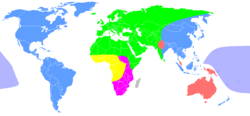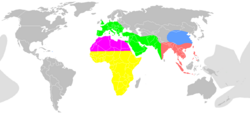Carleton S. Coon
Template:Cleanup-date Carleton Stevens Coon, (23 June 1904 – 3 June 1981) was an American physical anthropologist best remembered for his books on race.
Biography
Carleton Coon was born in Wakefield, Massachusetts to an established Yankee family. He developed an interest in prehistory, and attended Phillips Academy, Andover where he studied hieroglyphics and also developed an excellent profiency in ancient Greek. Coon went on to study at Harvard, where he began to study Egyptology with George Reisner. However he, like many students, was swayed to the field of anthropology by Earnest Hooton and he graduated magna cum laude in 1925.
Coon continued on in Harvard, making the first of many trips to North Africa in 1925 to conduct fieldwork in the Rif area of Morocco, which was still politically unsettled after a rebellion of the local populace against the Spanish. He earned his Ph.D. in 1928 and returned to Harvard as a lecturer and later a professor. His work from this period included a 1939 rewrite of William Z. Ripley's 1899 The Races of Europe. Coon was a colorful character who both undertook adventuresome exploits and like his mentor Earnest Hooton he wrote widely for a general audience. He published several novels and fictionalized accounts of his trips to North Africa, including The Riffians, Flesh of the Wild Ox, Measuring Ethiopia, and A North Africa Story: The Anthropologist as OSS Agent.
This last book was an account of his work during World War II, which involved espionage and the smuggling of arms to French resistance groups in German-occupied Morocco under the guise of anthropological fieldwork, a practice generally condemned by working anthropologists today, in the context the 21st century science ethics.
In 1948, Coon left Harvard to take up a position as Professor of Anthropology at the University of Pennsylvania, which had an excellent museum attached to it. Throughout the 1950s he produced a series of academic papers, as well as many popular books for the general reader, the most notable being The Story of Man (1954). Coon's own interest was in attempting to use Darwin's theory of natural selection to explain the differing physical characteristics of various racial groups.
Racial Theories
Carleton Coon believed different racial types fought for domination and annihilation of other racial types. He believed Europe was the refined product of a long history of racial progression. He believed that historically "different strains in one population have showed differential survival values and often one has reemerged at the expense of others (in Europeans)", according to his book The Races of Europe, The White Race and the New World. He believed the "maximum survival" of Europeans was increased by their replacement of the indigenous peoples of the "New World".(The Races of Europe, The White Race and the New World) He believed the history of the White race to have involved "racial survivals" of the different White subraces. (The Races of Europe, Chapter II Sec 12)
Carleton Coon did not embrace the Caucasoid racial identity he defined; he instead embraced a White racial identity. In his book the Races of Europe he mentions the term Caucasoid only in passing. He mentions the White race as more a primary identification. In his introduction of the Races of Europe he states the "concern (of his book) the somatic character of peoples belonging to the white race". Also, this can be seen in his first chapter entitled "Introduction to the Historical Study of the White Race" and his ending chapter entitled "The White Race and the New World". In other sections of his Races of Europe book he mentions people to be "European in racial type" and having a "European racial element" (Races of Europe, Chapter 7 Turks and Mongols) He did not consider studying non-White races to be of high importance. He advised studying the versions of European racial types seen in the quote from his book Races of Europe, "What is needed more than anything else in this respect is a thoroughgoing study of the inhabitants of the principal and most powerful nations of Europe".
Carleton Coon believed Whites followed a separate evolutionary path from other humans. He believed "The earliest Homo sapiens known, as represented by several examples from Europe and Africa, was an ancestral long-headed white man of short stature and moderately great brain size." and "the negro group probably evolved parallel to the white strain" (The Races of Europe, Chapter II)
In 1962, he published his magnum opus The Origin of Races. Unfortunately for Coon, physical anthropology had changed greatly since his time as an undergraduate at Harvard. Contemporary researchers such as Sherwood Washburn and Ashley Montagu were heavily influenced by the modern synthesis in biology and population genetics, as well as a Boasian revolt against typological racial thinking. The human species was now seen as a continuous serial progression of populations rather than the five parallel genetically distinct races. The 1960s were a controversial time for racial theories, and Coon's cousin Carleton Putnam suggested that Coon's work, among others, justified racial segregation. Coon stepped down as President of the American Association of Physical Anthropologists in disgust after the association voted to censure Putnam's book Race and Reason: A Yankee view. Coon continued to write and defend his work. He died on June 3, 1981, in Gloucester, Massachusetts.
|
Legacy
Coon's hypothesis that modern humans, Homo sapiens, arose five separate times from Homo erectus in five separate places, "as each subspecies, living in its own territory, passed a critical threshold from a more brutal to a more sapient state", thus providing origins in deep time for his five races of mankind, no longer has wide currency among scholars, and his using this to rank different races struck many commentators of resembling the scientific racism of the early twentieth century (one page in Coon's book contrasted a picture of an Australian Aborigine called "Topsy" with a Chinese professor, and was captioned "The Alpha and the Omega"). See Multi-regional origin for a discussion of theories of this type. Discovery of a possible hybrid Homo sapiens X neanderthalensis fossil child at the Abrigo do Lagar Velho rock-shelter site in Portugal in 1999 raised hopes of rehabilitating the Multiregional hypothesis of which Coon was a proponent.
Works by Carleton S. Coon
- The Origin of Races (1962)
- The Story of Man (1954)
- The Races of Europe (1939)
- Races: A Study of the Problems of Race Formation in Man
- The Hunting Peoples
- Anthropology A to Z (1963)
- Living Races of Man (1965)
- Seven Caves: Archaeological Exploration in the Middle East
- Adventures and Discoveries: The Autobiography of Carleton S. Coon (1981)
- Mountains of Giants: A Racial and Cultural Study of the North Albanian Mountain Ghegs
- Yengema Cave Report (his work in Sierra Leone)
- Caravan: the Story of the Middle East (1958). A North Africa Story (1980)
- Racial Adaptations (1982)
Quotes
"It is the retention by twentieth-century, Atom-Age men of the Neolithic point of view that says: You stay in your village and I will stay in mine. If your sheep eat our grass we will kill you, or we may kill you anyhow to get all the grass for our own sheep. Anyone who tries to make us change our ways is a witch and we will kill him. Keep out of our village." —The Story of Man, 1954, page 376
Further reading and sources
- The Hybrid Child from Portugal [1]
- Hybrid Humans? Archaeological Institute of America Volume 52 Number 4, July/August 1999 by Spencer P.M. Harrington [2]
- Races of Europe by Carleton Coon 1939 [3]
- Carleton Steven Coons, 23 June 1904 - 3 June 1981 (obituary). 1989. W.W. Howells in Biographical Memoirs of the National Academy of Sciences of the United States of America, v.58 108-131.
- Two Views of Coon's Origin of Races with Comments by Coon and Replies. 1963. Theodosius Dobzhansky; Ashley Montagu; C. S. Coon in Current Anthropology, Vol. 4, No. 4. (Oct., 1963), pp. 360-367.
External links
- Carleton Stevens Coon Papers, National Anthropological Archives, Smithsonian Institution
- "The Races of Europe" by Carleton S. Coon - collection of physical anthropolgical data on the indigenous European populations.
Credits
New World Encyclopedia writers and editors rewrote and completed the Wikipedia article in accordance with New World Encyclopedia standards. This article abides by terms of the Creative Commons CC-by-sa 3.0 License (CC-by-sa), which may be used and disseminated with proper attribution. Credit is due under the terms of this license that can reference both the New World Encyclopedia contributors and the selfless volunteer contributors of the Wikimedia Foundation. To cite this article click here for a list of acceptable citing formats.The history of earlier contributions by wikipedians is accessible to researchers here:
The history of this article since it was imported to New World Encyclopedia:
Note: Some restrictions may apply to use of individual images which are separately licensed.

